Determinants of Household Income in Rural Pakistan: A Detailed Report
VerifiedAdded on 2023/07/07
|7
|1871
|85
Report
AI Summary
This report examines the determinants of household income in rural Pakistan, focusing on factors such as agriculture, education, infrastructure, financial services, and gender disparities. It highlights the significant role of the agriculture sector, land ownership, access to credit, and modern farming methods in influencing rural household income. The report emphasizes the importance of education and human capital development for economic mobility and higher-paying jobs. It also addresses the challenges faced by rural households, including unequal land distribution, climate change impacts, market access issues, and cultural barriers. The literature review covers studies on cooking fuel choices, child mortality rates, and climate change adaptations, providing empirical evidence to guide policy interventions and poverty reduction strategies. The report concludes by stressing the need for evidence-based policymaking, improved agricultural practices, enhanced education and skills, infrastructure development, and financial inclusion to improve rural income levels in Pakistan. Desklib provides access to this report and many other solved assignments for students.

GOVT. POST GRADUATE COLLEGE FOR GIRLS, SAMUNDRI
DETERMINANTS OF HOUSEHOLD INCOME IN RURAL
PAKISTAN
Submitted By: Esha Saleem
Roll No.: 167130
DETERMINANTS OF HOUSEHOLD INCOME IN RURAL
PAKISTAN
Submitted By: Esha Saleem
Roll No.: 167130
Paraphrase This Document
Need a fresh take? Get an instant paraphrase of this document with our AI Paraphraser
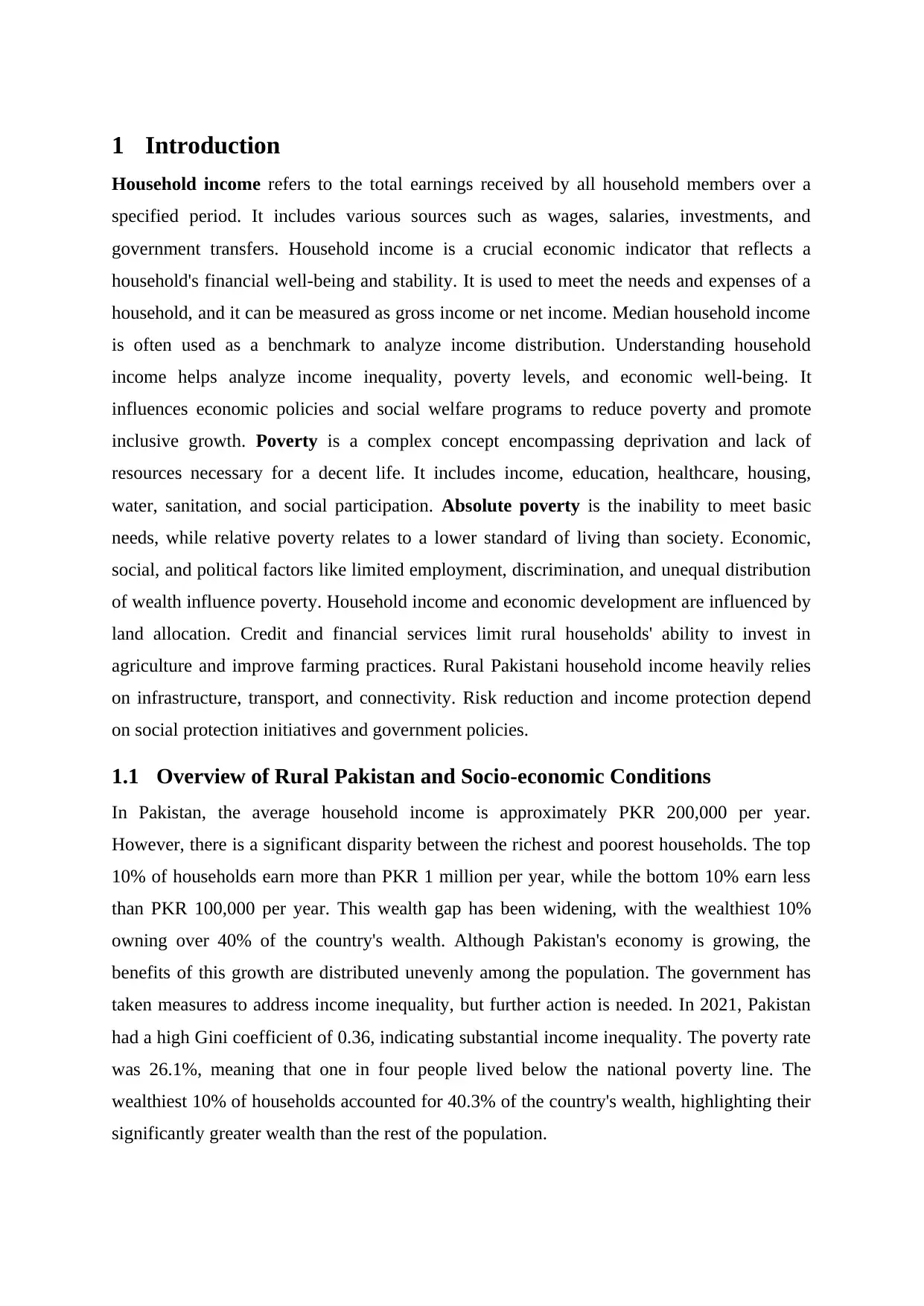
1 Introduction
Household income refers to the total earnings received by all household members over a
specified period. It includes various sources such as wages, salaries, investments, and
government transfers. Household income is a crucial economic indicator that reflects a
household's financial well-being and stability. It is used to meet the needs and expenses of a
household, and it can be measured as gross income or net income. Median household income
is often used as a benchmark to analyze income distribution. Understanding household
income helps analyze income inequality, poverty levels, and economic well-being. It
influences economic policies and social welfare programs to reduce poverty and promote
inclusive growth. Poverty is a complex concept encompassing deprivation and lack of
resources necessary for a decent life. It includes income, education, healthcare, housing,
water, sanitation, and social participation. Absolute poverty is the inability to meet basic
needs, while relative poverty relates to a lower standard of living than society. Economic,
social, and political factors like limited employment, discrimination, and unequal distribution
of wealth influence poverty. Household income and economic development are influenced by
land allocation. Credit and financial services limit rural households' ability to invest in
agriculture and improve farming practices. Rural Pakistani household income heavily relies
on infrastructure, transport, and connectivity. Risk reduction and income protection depend
on social protection initiatives and government policies.
1.1 Overview of Rural Pakistan and Socio-economic Conditions
In Pakistan, the average household income is approximately PKR 200,000 per year.
However, there is a significant disparity between the richest and poorest households. The top
10% of households earn more than PKR 1 million per year, while the bottom 10% earn less
than PKR 100,000 per year. This wealth gap has been widening, with the wealthiest 10%
owning over 40% of the country's wealth. Although Pakistan's economy is growing, the
benefits of this growth are distributed unevenly among the population. The government has
taken measures to address income inequality, but further action is needed. In 2021, Pakistan
had a high Gini coefficient of 0.36, indicating substantial income inequality. The poverty rate
was 26.1%, meaning that one in four people lived below the national poverty line. The
wealthiest 10% of households accounted for 40.3% of the country's wealth, highlighting their
significantly greater wealth than the rest of the population.
Household income refers to the total earnings received by all household members over a
specified period. It includes various sources such as wages, salaries, investments, and
government transfers. Household income is a crucial economic indicator that reflects a
household's financial well-being and stability. It is used to meet the needs and expenses of a
household, and it can be measured as gross income or net income. Median household income
is often used as a benchmark to analyze income distribution. Understanding household
income helps analyze income inequality, poverty levels, and economic well-being. It
influences economic policies and social welfare programs to reduce poverty and promote
inclusive growth. Poverty is a complex concept encompassing deprivation and lack of
resources necessary for a decent life. It includes income, education, healthcare, housing,
water, sanitation, and social participation. Absolute poverty is the inability to meet basic
needs, while relative poverty relates to a lower standard of living than society. Economic,
social, and political factors like limited employment, discrimination, and unequal distribution
of wealth influence poverty. Household income and economic development are influenced by
land allocation. Credit and financial services limit rural households' ability to invest in
agriculture and improve farming practices. Rural Pakistani household income heavily relies
on infrastructure, transport, and connectivity. Risk reduction and income protection depend
on social protection initiatives and government policies.
1.1 Overview of Rural Pakistan and Socio-economic Conditions
In Pakistan, the average household income is approximately PKR 200,000 per year.
However, there is a significant disparity between the richest and poorest households. The top
10% of households earn more than PKR 1 million per year, while the bottom 10% earn less
than PKR 100,000 per year. This wealth gap has been widening, with the wealthiest 10%
owning over 40% of the country's wealth. Although Pakistan's economy is growing, the
benefits of this growth are distributed unevenly among the population. The government has
taken measures to address income inequality, but further action is needed. In 2021, Pakistan
had a high Gini coefficient of 0.36, indicating substantial income inequality. The poverty rate
was 26.1%, meaning that one in four people lived below the national poverty line. The
wealthiest 10% of households accounted for 40.3% of the country's wealth, highlighting their
significantly greater wealth than the rest of the population.
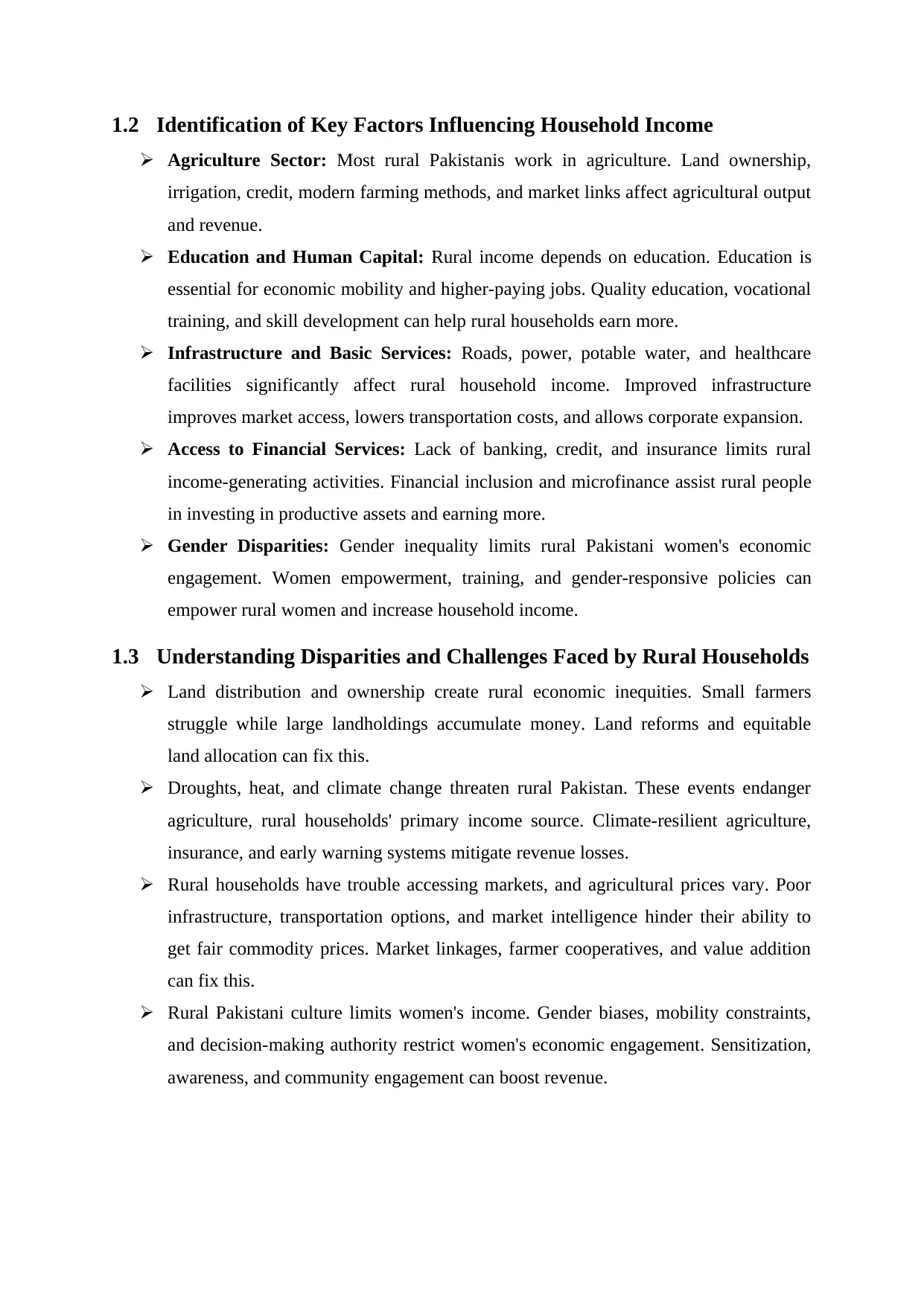
1.2 Identification of Key Factors Influencing Household Income
Agriculture Sector: Most rural Pakistanis work in agriculture. Land ownership,
irrigation, credit, modern farming methods, and market links affect agricultural output
and revenue.
Education and Human Capital: Rural income depends on education. Education is
essential for economic mobility and higher-paying jobs. Quality education, vocational
training, and skill development can help rural households earn more.
Infrastructure and Basic Services: Roads, power, potable water, and healthcare
facilities significantly affect rural household income. Improved infrastructure
improves market access, lowers transportation costs, and allows corporate expansion.
Access to Financial Services: Lack of banking, credit, and insurance limits rural
income-generating activities. Financial inclusion and microfinance assist rural people
in investing in productive assets and earning more.
Gender Disparities: Gender inequality limits rural Pakistani women's economic
engagement. Women empowerment, training, and gender-responsive policies can
empower rural women and increase household income.
1.3 Understanding Disparities and Challenges Faced by Rural Households
Land distribution and ownership create rural economic inequities. Small farmers
struggle while large landholdings accumulate money. Land reforms and equitable
land allocation can fix this.
Droughts, heat, and climate change threaten rural Pakistan. These events endanger
agriculture, rural households' primary income source. Climate-resilient agriculture,
insurance, and early warning systems mitigate revenue losses.
Rural households have trouble accessing markets, and agricultural prices vary. Poor
infrastructure, transportation options, and market intelligence hinder their ability to
get fair commodity prices. Market linkages, farmer cooperatives, and value addition
can fix this.
Rural Pakistani culture limits women's income. Gender biases, mobility constraints,
and decision-making authority restrict women's economic engagement. Sensitization,
awareness, and community engagement can boost revenue.
Agriculture Sector: Most rural Pakistanis work in agriculture. Land ownership,
irrigation, credit, modern farming methods, and market links affect agricultural output
and revenue.
Education and Human Capital: Rural income depends on education. Education is
essential for economic mobility and higher-paying jobs. Quality education, vocational
training, and skill development can help rural households earn more.
Infrastructure and Basic Services: Roads, power, potable water, and healthcare
facilities significantly affect rural household income. Improved infrastructure
improves market access, lowers transportation costs, and allows corporate expansion.
Access to Financial Services: Lack of banking, credit, and insurance limits rural
income-generating activities. Financial inclusion and microfinance assist rural people
in investing in productive assets and earning more.
Gender Disparities: Gender inequality limits rural Pakistani women's economic
engagement. Women empowerment, training, and gender-responsive policies can
empower rural women and increase household income.
1.3 Understanding Disparities and Challenges Faced by Rural Households
Land distribution and ownership create rural economic inequities. Small farmers
struggle while large landholdings accumulate money. Land reforms and equitable
land allocation can fix this.
Droughts, heat, and climate change threaten rural Pakistan. These events endanger
agriculture, rural households' primary income source. Climate-resilient agriculture,
insurance, and early warning systems mitigate revenue losses.
Rural households have trouble accessing markets, and agricultural prices vary. Poor
infrastructure, transportation options, and market intelligence hinder their ability to
get fair commodity prices. Market linkages, farmer cooperatives, and value addition
can fix this.
Rural Pakistani culture limits women's income. Gender biases, mobility constraints,
and decision-making authority restrict women's economic engagement. Sensitization,
awareness, and community engagement can boost revenue.
⊘ This is a preview!⊘
Do you want full access?
Subscribe today to unlock all pages.

Trusted by 1+ million students worldwide

1.4 The Need for Empirical Evidence to Guide Policy Interventions and
Poverty Reduction Strategies
Evidence-based policymaking involves robust data collection and analysis, involving
collaboration between government, NGOs, institutions, and international
organizations to support rural households.
Agriculture sustains rural Pakistan, with modern farming, financing, irrigation, and
crop management enhancing household incomes. Water shortages, climate change,
and agricultural infrastructure can boost rural earnings.
Education and skills are crucial for rural families to escape poverty. Infrastructure
improves market access, transportation costs, trade, and economic activity, boosting
household incomes. Conventional banking is essential for rural economies to expand
and diversify, with financial institutions, microfinance, and rural savings and
investment increasing income.
1.5 Research Questions
1) What are the main determinants of household income in rural Pakistan?
2) How to do education, land ownership, and market access affect rural household
income?
3) What policy recommendations can be derived from the findings to improve rural
income levels?
Poverty Reduction Strategies
Evidence-based policymaking involves robust data collection and analysis, involving
collaboration between government, NGOs, institutions, and international
organizations to support rural households.
Agriculture sustains rural Pakistan, with modern farming, financing, irrigation, and
crop management enhancing household incomes. Water shortages, climate change,
and agricultural infrastructure can boost rural earnings.
Education and skills are crucial for rural families to escape poverty. Infrastructure
improves market access, transportation costs, trade, and economic activity, boosting
household incomes. Conventional banking is essential for rural economies to expand
and diversify, with financial institutions, microfinance, and rural savings and
investment increasing income.
1.5 Research Questions
1) What are the main determinants of household income in rural Pakistan?
2) How to do education, land ownership, and market access affect rural household
income?
3) What policy recommendations can be derived from the findings to improve rural
income levels?
Paraphrase This Document
Need a fresh take? Get an instant paraphrase of this document with our AI Paraphraser
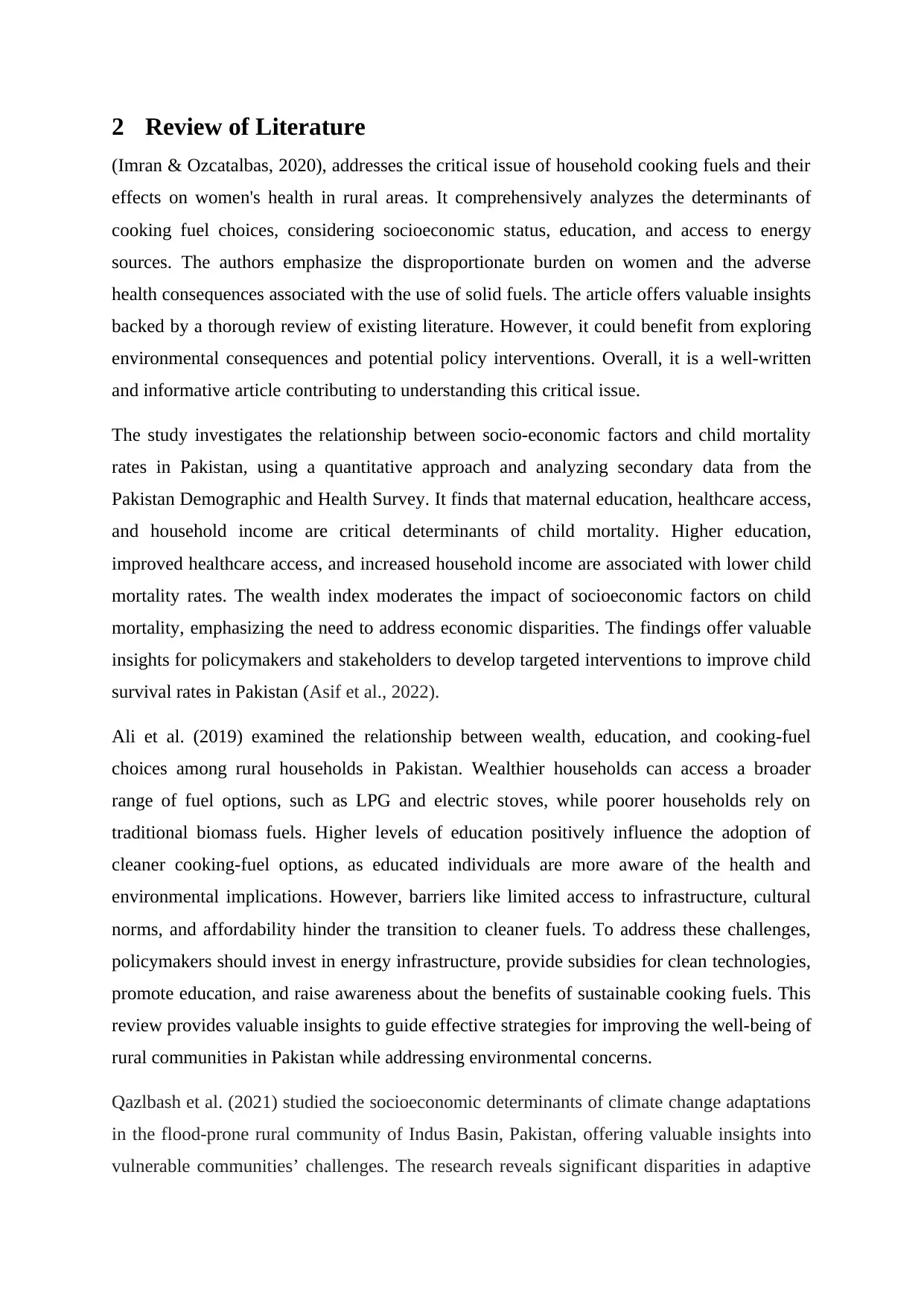
2 Review of Literature
(Imran & Ozcatalbas, 2020), addresses the critical issue of household cooking fuels and their
effects on women's health in rural areas. It comprehensively analyzes the determinants of
cooking fuel choices, considering socioeconomic status, education, and access to energy
sources. The authors emphasize the disproportionate burden on women and the adverse
health consequences associated with the use of solid fuels. The article offers valuable insights
backed by a thorough review of existing literature. However, it could benefit from exploring
environmental consequences and potential policy interventions. Overall, it is a well-written
and informative article contributing to understanding this critical issue.
The study investigates the relationship between socio-economic factors and child mortality
rates in Pakistan, using a quantitative approach and analyzing secondary data from the
Pakistan Demographic and Health Survey. It finds that maternal education, healthcare access,
and household income are critical determinants of child mortality. Higher education,
improved healthcare access, and increased household income are associated with lower child
mortality rates. The wealth index moderates the impact of socioeconomic factors on child
mortality, emphasizing the need to address economic disparities. The findings offer valuable
insights for policymakers and stakeholders to develop targeted interventions to improve child
survival rates in Pakistan (Asif et al., 2022).
Ali et al. (2019) examined the relationship between wealth, education, and cooking-fuel
choices among rural households in Pakistan. Wealthier households can access a broader
range of fuel options, such as LPG and electric stoves, while poorer households rely on
traditional biomass fuels. Higher levels of education positively influence the adoption of
cleaner cooking-fuel options, as educated individuals are more aware of the health and
environmental implications. However, barriers like limited access to infrastructure, cultural
norms, and affordability hinder the transition to cleaner fuels. To address these challenges,
policymakers should invest in energy infrastructure, provide subsidies for clean technologies,
promote education, and raise awareness about the benefits of sustainable cooking fuels. This
review provides valuable insights to guide effective strategies for improving the well-being of
rural communities in Pakistan while addressing environmental concerns.
Qazlbash et al. (2021) studied the socioeconomic determinants of climate change adaptations
in the flood-prone rural community of Indus Basin, Pakistan, offering valuable insights into
vulnerable communities’ challenges. The research reveals significant disparities in adaptive
(Imran & Ozcatalbas, 2020), addresses the critical issue of household cooking fuels and their
effects on women's health in rural areas. It comprehensively analyzes the determinants of
cooking fuel choices, considering socioeconomic status, education, and access to energy
sources. The authors emphasize the disproportionate burden on women and the adverse
health consequences associated with the use of solid fuels. The article offers valuable insights
backed by a thorough review of existing literature. However, it could benefit from exploring
environmental consequences and potential policy interventions. Overall, it is a well-written
and informative article contributing to understanding this critical issue.
The study investigates the relationship between socio-economic factors and child mortality
rates in Pakistan, using a quantitative approach and analyzing secondary data from the
Pakistan Demographic and Health Survey. It finds that maternal education, healthcare access,
and household income are critical determinants of child mortality. Higher education,
improved healthcare access, and increased household income are associated with lower child
mortality rates. The wealth index moderates the impact of socioeconomic factors on child
mortality, emphasizing the need to address economic disparities. The findings offer valuable
insights for policymakers and stakeholders to develop targeted interventions to improve child
survival rates in Pakistan (Asif et al., 2022).
Ali et al. (2019) examined the relationship between wealth, education, and cooking-fuel
choices among rural households in Pakistan. Wealthier households can access a broader
range of fuel options, such as LPG and electric stoves, while poorer households rely on
traditional biomass fuels. Higher levels of education positively influence the adoption of
cleaner cooking-fuel options, as educated individuals are more aware of the health and
environmental implications. However, barriers like limited access to infrastructure, cultural
norms, and affordability hinder the transition to cleaner fuels. To address these challenges,
policymakers should invest in energy infrastructure, provide subsidies for clean technologies,
promote education, and raise awareness about the benefits of sustainable cooking fuels. This
review provides valuable insights to guide effective strategies for improving the well-being of
rural communities in Pakistan while addressing environmental concerns.
Qazlbash et al. (2021) studied the socioeconomic determinants of climate change adaptations
in the flood-prone rural community of Indus Basin, Pakistan, offering valuable insights into
vulnerable communities’ challenges. The research reveals significant disparities in adaptive
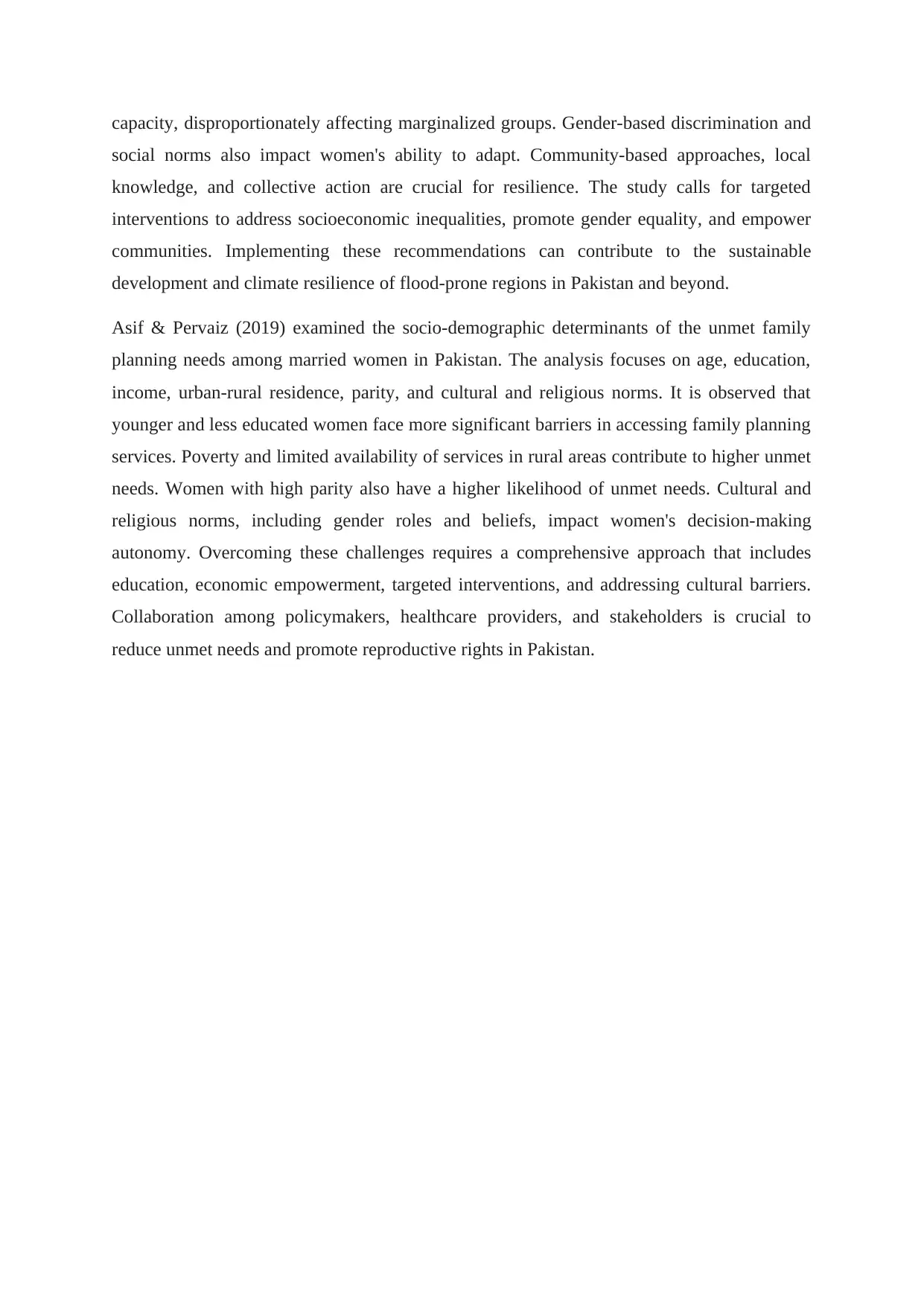
capacity, disproportionately affecting marginalized groups. Gender-based discrimination and
social norms also impact women's ability to adapt. Community-based approaches, local
knowledge, and collective action are crucial for resilience. The study calls for targeted
interventions to address socioeconomic inequalities, promote gender equality, and empower
communities. Implementing these recommendations can contribute to the sustainable
development and climate resilience of flood-prone regions in Pakistan and beyond.
Asif & Pervaiz (2019) examined the socio-demographic determinants of the unmet family
planning needs among married women in Pakistan. The analysis focuses on age, education,
income, urban-rural residence, parity, and cultural and religious norms. It is observed that
younger and less educated women face more significant barriers in accessing family planning
services. Poverty and limited availability of services in rural areas contribute to higher unmet
needs. Women with high parity also have a higher likelihood of unmet needs. Cultural and
religious norms, including gender roles and beliefs, impact women's decision-making
autonomy. Overcoming these challenges requires a comprehensive approach that includes
education, economic empowerment, targeted interventions, and addressing cultural barriers.
Collaboration among policymakers, healthcare providers, and stakeholders is crucial to
reduce unmet needs and promote reproductive rights in Pakistan.
social norms also impact women's ability to adapt. Community-based approaches, local
knowledge, and collective action are crucial for resilience. The study calls for targeted
interventions to address socioeconomic inequalities, promote gender equality, and empower
communities. Implementing these recommendations can contribute to the sustainable
development and climate resilience of flood-prone regions in Pakistan and beyond.
Asif & Pervaiz (2019) examined the socio-demographic determinants of the unmet family
planning needs among married women in Pakistan. The analysis focuses on age, education,
income, urban-rural residence, parity, and cultural and religious norms. It is observed that
younger and less educated women face more significant barriers in accessing family planning
services. Poverty and limited availability of services in rural areas contribute to higher unmet
needs. Women with high parity also have a higher likelihood of unmet needs. Cultural and
religious norms, including gender roles and beliefs, impact women's decision-making
autonomy. Overcoming these challenges requires a comprehensive approach that includes
education, economic empowerment, targeted interventions, and addressing cultural barriers.
Collaboration among policymakers, healthcare providers, and stakeholders is crucial to
reduce unmet needs and promote reproductive rights in Pakistan.
⊘ This is a preview!⊘
Do you want full access?
Subscribe today to unlock all pages.

Trusted by 1+ million students worldwide
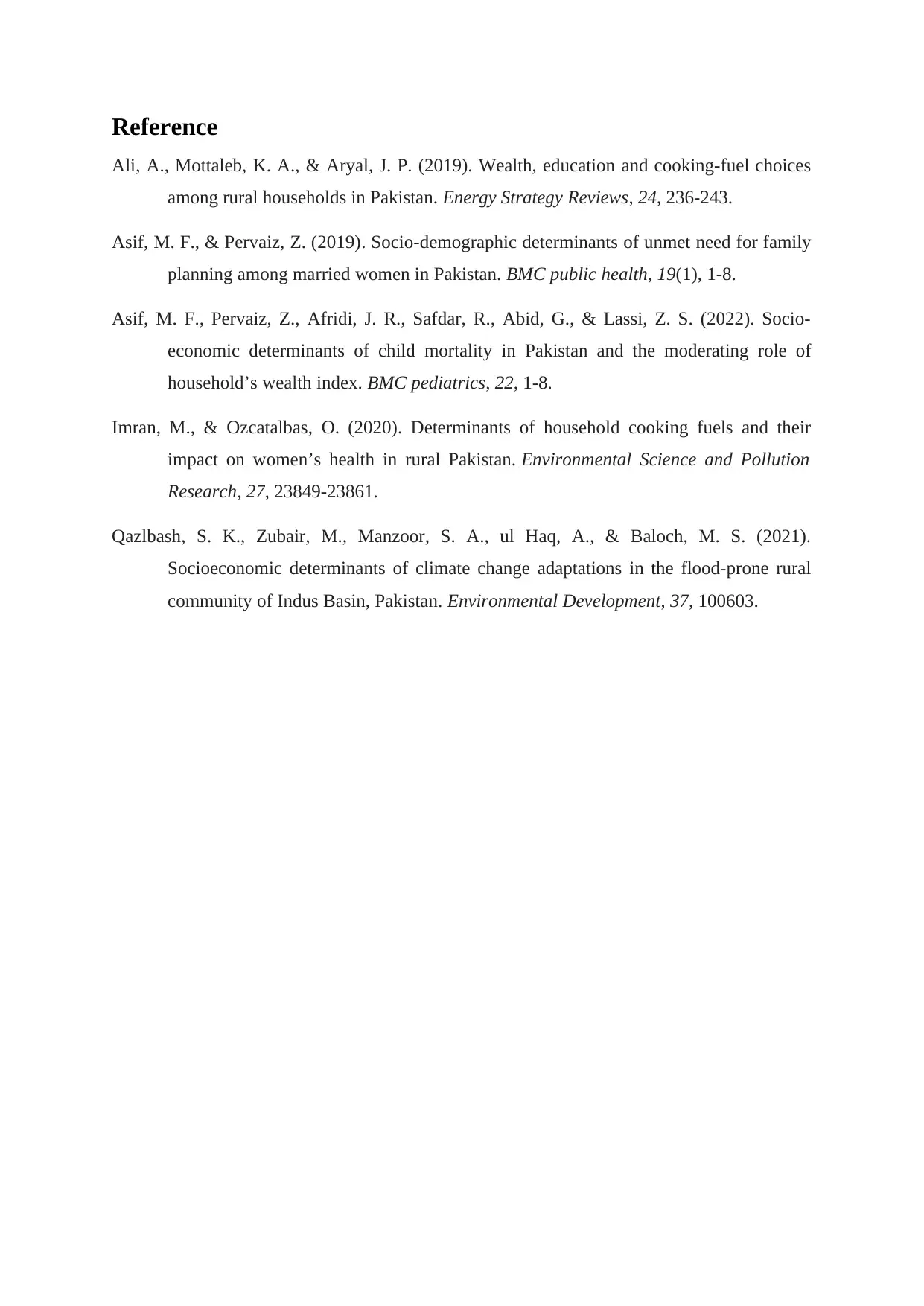
Reference
Ali, A., Mottaleb, K. A., & Aryal, J. P. (2019). Wealth, education and cooking-fuel choices
among rural households in Pakistan. Energy Strategy Reviews, 24, 236-243.
Asif, M. F., & Pervaiz, Z. (2019). Socio-demographic determinants of unmet need for family
planning among married women in Pakistan. BMC public health, 19(1), 1-8.
Asif, M. F., Pervaiz, Z., Afridi, J. R., Safdar, R., Abid, G., & Lassi, Z. S. (2022). Socio-
economic determinants of child mortality in Pakistan and the moderating role of
household’s wealth index. BMC pediatrics, 22, 1-8.
Imran, M., & Ozcatalbas, O. (2020). Determinants of household cooking fuels and their
impact on women’s health in rural Pakistan. Environmental Science and Pollution
Research, 27, 23849-23861.
Qazlbash, S. K., Zubair, M., Manzoor, S. A., ul Haq, A., & Baloch, M. S. (2021).
Socioeconomic determinants of climate change adaptations in the flood-prone rural
community of Indus Basin, Pakistan. Environmental Development, 37, 100603.
Ali, A., Mottaleb, K. A., & Aryal, J. P. (2019). Wealth, education and cooking-fuel choices
among rural households in Pakistan. Energy Strategy Reviews, 24, 236-243.
Asif, M. F., & Pervaiz, Z. (2019). Socio-demographic determinants of unmet need for family
planning among married women in Pakistan. BMC public health, 19(1), 1-8.
Asif, M. F., Pervaiz, Z., Afridi, J. R., Safdar, R., Abid, G., & Lassi, Z. S. (2022). Socio-
economic determinants of child mortality in Pakistan and the moderating role of
household’s wealth index. BMC pediatrics, 22, 1-8.
Imran, M., & Ozcatalbas, O. (2020). Determinants of household cooking fuels and their
impact on women’s health in rural Pakistan. Environmental Science and Pollution
Research, 27, 23849-23861.
Qazlbash, S. K., Zubair, M., Manzoor, S. A., ul Haq, A., & Baloch, M. S. (2021).
Socioeconomic determinants of climate change adaptations in the flood-prone rural
community of Indus Basin, Pakistan. Environmental Development, 37, 100603.
1 out of 7
Your All-in-One AI-Powered Toolkit for Academic Success.
+13062052269
info@desklib.com
Available 24*7 on WhatsApp / Email
![[object Object]](/_next/static/media/star-bottom.7253800d.svg)
Unlock your academic potential
Copyright © 2020–2026 A2Z Services. All Rights Reserved. Developed and managed by ZUCOL.
